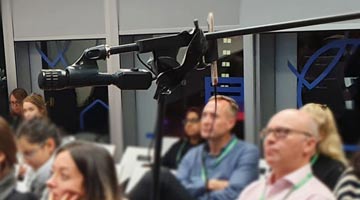Learn how to pitch to the press from the pros
By Anne Nicholls
July 29 2019

The first event of the CIPR’s newly-revived Not-for-Profit group on 17 July attracted an enthusiastic audience of around 25 communications pros from across the sector, boosted by another 10 who joined remotely.
The focus of the event was media relations. Despite the changing media landscape, pitching stories to journalists is still a core skill for many PR professionals. Guest speakers Alan Jones, Industrial Correspondent at the Press Association and Jess Austin, Deputy Communities Editor at Metro.co.uk, provided an insight into how they work, the kind of stories they cover and what’s new in the media world.
Alan Jones, one of the longest serving journalists at the Press Association (PA), has lived through decades of changes. In its early days the majority of the PA’s work was providing stories for regional media via ‘the wire’. Now they appear online. Stories come from three main sources: events (such as a strike at Heathrow Airport), government announcements (although fewer now that Brexit has skewed everything) and pitches from PROs. The latter tend to be product launches, reports and surveys. Although Alan is cynical about PR-generated surveys that are often a guise for pushing a product, he says there is still a market for well-crafted stories with case studies, strong quotes and a clear message. Pictures (and increasingly video) are important and may make the difference between a story being used or not, he adds
“So, what makes a story,” asked one delegate? “There isn’t a magic bullet to getting a story covered,” says Alan. Like many journalists, they know a good story when they see one but can’t necessarily articulate why it works. It’s largely a matter of gut instinct.
Alan works at speed, typically spending 30-60 minutes on each story, starting around 7.30am. His brief covers anything to do with the world of work. As the PA audience is non-specialist stories need a broad appeal. “We’re right at the sharp end of news,” he says. “Quite a lot of the stuff I get sent is better suited to a specific group of people, so would be more relevant to a specialist magazine.”
Sending an untargeted email is not the best approach, as the PA receives hundreds per hour to the generic inbox. It’s important to target a named person such as a specialist correspondent. Sadly, most journalists are office bound which means they have little time to meet people or even discuss story angles over the phone, although unlike many of his colleagues Alan says he does likes to chat. The good news is that if a PR can come up with a carefully packaged story with case studies, quotes and photos it has a reasonable chance of being used. An added bonus is that if you give Alan an exclusive it will go out to around 700 media outlets.
Jess Austin is deputy editor of Metro.co.uk’s communities section which features three types of content: analysis, opinion pieces and personal stories. The target audience is professionals in their late 20s, predominantly females. Although there are regular columnists such as Caroline Lucas MP, Jess is keen to feature diverse content from people that normally would not get a voice. She does not write the pieces, but instead sources and edits work by commissioned writers. They could be opinion pieces on community stories or first-person stories with a wider angle from people who have particular expertise or real life experience and a strong message.
Jess is keen that contributors get recognition so the writer will get a by-line and will see any edits before the piece goes live. “I need to see that the person is genuinely invested in the issue and has a strong conclusion or message that gets people thinking,” says Jess. “A unique take on a topic is what I like.”
Three recent examples are a first person piece on how a writer’s wife’s cancer diagnosis changed the way he loved her, for their ongoing ‘Love, Or Something Like It’ series. Another is one about how emoji are made by The Unicode Consortium, who are in charge of the process. A third example is a piece on what we can learn from the women of the Real Housewives series on TV.
Like many journalists, Jess is constantly trawling through Twitter for inspiration. But unlike some she is happy to talk through ideas over the phone or face-to-face. “I do go out for coffee occasionally and am happy to meet people, as I appreciate opinion pieces can be tricky and it can be easier to talk though what we’re looking for.“
Event takeaways
• Having a strong story is crucial. Unfortunately few journalists will be able to tell you exactly what being “newsworthy” means; you have to work it out for yourself.
• Despite reports about its demise, the press release is not dead. But it must contain a strong story, punchy quotes and an eye-catching title. As journalists increasingly have little time to research stories having something that is ready to use saves them time.
• Always think of the target audience when you pitch or send a press release. Ask yourself: ‘Is this better suited to a more specialist audience or a different demographic?’
• Include photos with stories. Videos are useful as well, if you’re able to produce them.
• Emails need to be targeted to specific people, not sent to a generic inbox.
• Make sure you post your story on Twitter as a tweet can be taken up as a story (think Donald Trump).
• Relationships with journalists are important, but don’t expect them all to find time to meet you. Be patient and don’t keep pestering them.
• Timing is massively important. Anything after 3pm probably won’t get into that day’s PA news. Although less significant to Metro.co.uk, being topical and timely is important.